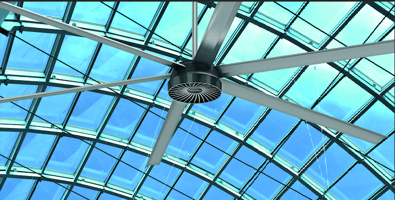Stay Comfortable All Year with HVLS Fans
HVLS fans have won over many owners and operators in a wide range of industries because they help lower energy costs, improve employee comfort and morale, and increase productivity for each season. To better understand their all-season functionality, one needs to have a little background on air movement.
Air and Air Circulation
Air is a fluid. It flows. Cool air flows down while warm air flows up. Air has mass, weight and volume. The success or failure of HVAC systems to move, treat and direct airflow sets the stage for the cost and comfort of operating any business that depends on large interior spaces.
In warehouses, malls, stadiums, or production facilities, air moves by natural convection and through forced systems. The ambient temperature and humidity from natural convection are only comfortable in the spring and fall. In the winter, HVAC systems work to push the artificially warmed air down. In the summer, HVAC systems work to push artificially cool air down.
Airflow Challenges with HVAC Systems
Several issues arise from forced airflow as delivered using only HVAC systems:
- Employees and customers feel uncomfortable drafts.
- Air stratification – layers of progressively hotter air rise while layers of cooler air stay down –especially in the winter.
- Pockets of hot or cold air form.
- Pushed artificial air (whether warm or cool) dissipates quickly.
- Production areas that receive treated air are localized, causing the remaining square footage to fluctuate unpredictably in temperature.
- Separate treatments are needed for heating and cooling.
HVLS Fans

High volume, low speed (HVLS) fans are an alternative air movement solution to small, high-speed fans. While small high-speed fans can move a column of air, the air will not travel far before it disperses and it’s likely to generate substantial friction (drag) against the existing air.
HVLS fans have blades up to 24 feet long – which is about six times the size of high-speed fan blades – and they move air in extremely large volumes. Because of their low speed, HVLS fans mimic natural airflow far better than smaller high-speed fans. In conjunction with existing HVAC systems, HVLS fans remedy many HVAC problems.
Three Wintertime Benefits of HVLS fans

- HVLS fans reduce air stratification: As warm (and expensively heated) air rises during winter, any attempt to force it down by small high-speed fans causes the air to cool. In addition, the smaller fan may only move one layer of the stratified air, and the warmer air above the fan may be unaffected. Imagine the column of air as a solid mass; it has a high surface area for its volume, so it cools faster than a larger mass. HVLS fans move large volumes of air gently, with minimal drag, so the heated air travels downward and retains its heat longer. However, this only works if the HVLS fan’s blade direction is reversed. MacroAir is the only HVLS fan manufacturer that designs fans to run in reverse.
- HVLS fans reduce drafts: Since the air that HVLS fans create moves at low speed, cold drafts are eliminated. Employees and customers are not hit by a narrow column of warm air or frozen by a cold wind, resulting in comfortable work conditions. With HVLS fans, employees can concentrate on their jobs without the anxiety about their comfort and health.
- HVLS fans reduce costs: HVLS fans capture and redistribute the pool of overhead heated air and mix the air to eliminate the hot and cold spots, which minimizes the amount of warm air that has to be continuously replaced with cold outside air. Savings will vary based on installation, local climate, and floor plan, but typical savings are 20 percent or more.

HVLS fans are an important and energy-saving addition to commercial, industrial and agricultural wintertime heating solutions. For more information on how MacroAir can help heat your space, click here.

